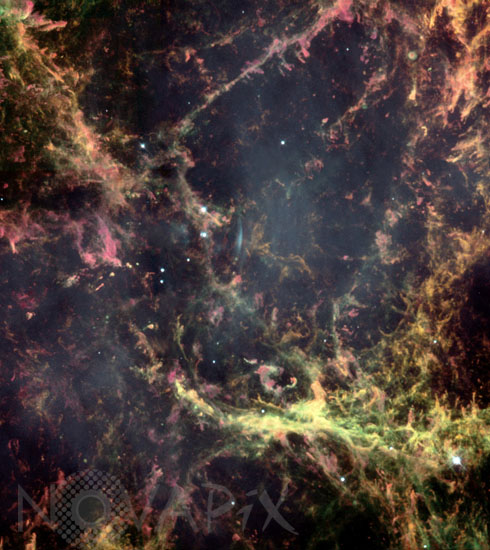Photo Agency - Astronomy - Space - Nature

The center of the Crab nebula
author: Nasa/Hubble heritage team/Novapix
reference: a-snv11-00524
Image Size 300 DPI: 8 * 9 cm
In the year 1054 A.D., Chinese astronomers were startled by the appearance of a new star, so bright that it was visible in broad daylight for several weeks. Located about 6,500 light-years from Earth, the Crab Nebula is the remnant of a star that began its life with about 10 times the mass of our own Sun. Its life ended on July 4, 1054 when it exploded as a supernova. In this image, NASA's Hubble Space Telescope has zoomed in on the center of the Crab to reveal its structure with unprecedented detail. The Crab Nebula data were obtained by Hubble's Wide Field and Planetary Camera 2 in 1995. Images taken with five different color filters have been combined to construct this new false-color picture. The core of the star has survived the explosion as a "pulsar," visible in the Hubble image as the lower of the two moderately bright stars to the upper left of center. The pulsar is a neutron star that spins on its axis 30 times a second. It heats its surroundings, creating the ghostly diffuse bluish-green glowing gas cloud in its vicinity, including a blue arc just to its right. The colorful network of filaments is the material from the outer layers of the star that was expelled during the explosion. The picture is somewhat deceptive in that the filaments appear to be close to the pulsar. In reality, the yellowish green filaments toward the bottom of the image are closer to us, and approaching at some 300 miles per second. The orange and pink filaments toward the top of the picture include material behind the pulsar, rushing away from us at similar speeds. The various colors in the picture arise from different chemical elements in the expanding gas, including hydrogen (orange), nitrogen (red), sulfur (pink), and oxygen (green). The shades of color represent variations in the temperature and density of the gas, as well as changes in the elemental composition. These chemical elements, some of them newly created during the evolution and explosion of the star and now blasted back into space, will eventually be incorporated into new stars and planets. Astronomers believe that the chemical elements in the Earth and even in our own bodies, such as carbon, oxygen, and iron, were made in other exploding stars billions of years ago.
Contact : Stéphane Aubin +33-(0)9-51-26-53-76
© Novapix - All rights reserved


